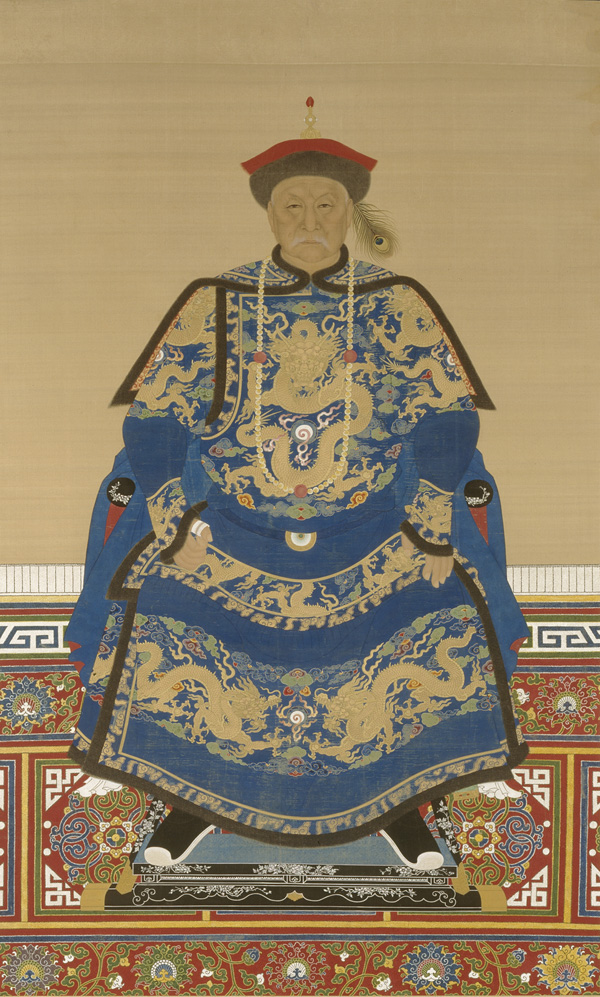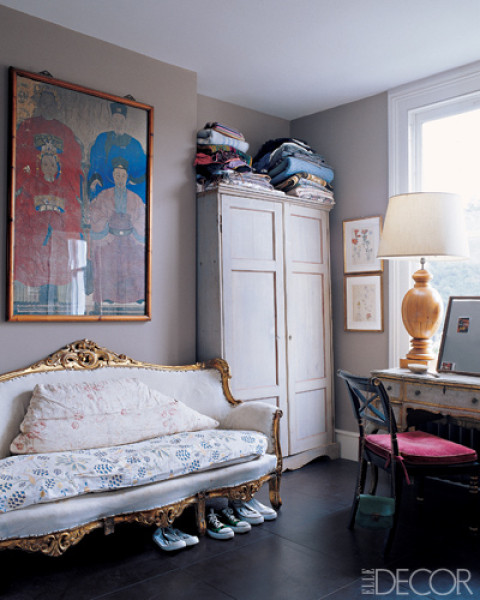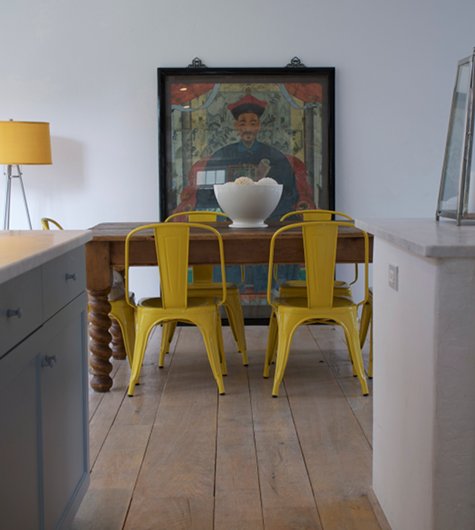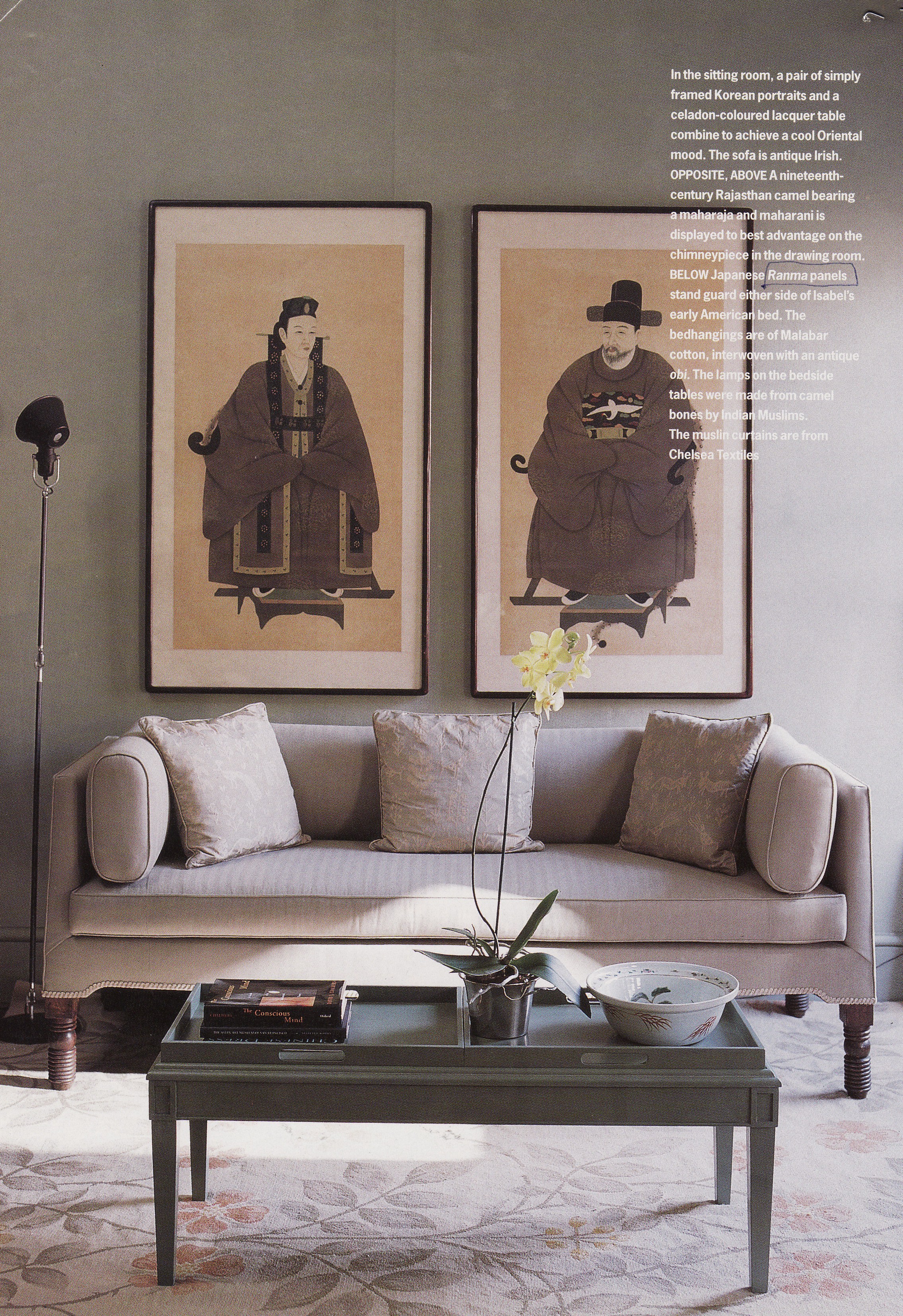 In honor of Chinese New Year, I am going to be writing about Chinese antiques this week, starting with one of the more unusual items – ancestor portraits. Commissioned by loved ones of the deceased, they were privately displayed and worshipped as the Chinese believed (and continue to believe) that the spirits of their ancestors could bring them health, long life, prosperity and children. Funerary statues and art date back to early Chinese history, but most of the surviving portraits date from the Qing Dynasty (1644-1911). During the 20th century, westerners began to buy up old portraits as photography became the medium of recording departed family members. In particular, Richard Pritzlaff, a reclusive horse breeder from New Mexico put together an extraordinary collection throughout the 1930s and 40s, which were then acquired by the Arthur M. Sackler Gallery in Washington, DC in 1991. But it was the exhibition Worshipping the Ancestors: Chinese Commemorative Portraits there in 2001 that sparked a changing viewpoint of the portraits as works of art and interest in them rose tremendously as a result. The museum continues to display the portraits fairly regularly, with an exhibition Family Matters: Portraits from the Qing Court just having closed.
In honor of Chinese New Year, I am going to be writing about Chinese antiques this week, starting with one of the more unusual items – ancestor portraits. Commissioned by loved ones of the deceased, they were privately displayed and worshipped as the Chinese believed (and continue to believe) that the spirits of their ancestors could bring them health, long life, prosperity and children. Funerary statues and art date back to early Chinese history, but most of the surviving portraits date from the Qing Dynasty (1644-1911). During the 20th century, westerners began to buy up old portraits as photography became the medium of recording departed family members. In particular, Richard Pritzlaff, a reclusive horse breeder from New Mexico put together an extraordinary collection throughout the 1930s and 40s, which were then acquired by the Arthur M. Sackler Gallery in Washington, DC in 1991. But it was the exhibition Worshipping the Ancestors: Chinese Commemorative Portraits there in 2001 that sparked a changing viewpoint of the portraits as works of art and interest in them rose tremendously as a result. The museum continues to display the portraits fairly regularly, with an exhibition Family Matters: Portraits from the Qing Court just having closed.
 Tear sheets of Virginia Witbeck’s apartment from the early 1990s were saved by me in great part for this small image of her in front of an ancestor portrait with a pair of stacking Japanese lacquer tray tables by her side. My interest in them was piqued. When I moved to Hong Kong in 1997, they were not yet that talked about and quite readily available for reasonable prices at many of the antique stores there. Copies and fakes had not become the problem they are today, nor had prices for the real deal risen as high as they have now. But there was great debate about whether or not it was appropriate to hang them as art in a stranger’s home. I had many friends who argued against them, feeling it was a form of sacrilege, while others wanted them for their incredible decorative potential. I was always torn by this argument and decided against one. I think I may rue that decision today.
Tear sheets of Virginia Witbeck’s apartment from the early 1990s were saved by me in great part for this small image of her in front of an ancestor portrait with a pair of stacking Japanese lacquer tray tables by her side. My interest in them was piqued. When I moved to Hong Kong in 1997, they were not yet that talked about and quite readily available for reasonable prices at many of the antique stores there. Copies and fakes had not become the problem they are today, nor had prices for the real deal risen as high as they have now. But there was great debate about whether or not it was appropriate to hang them as art in a stranger’s home. I had many friends who argued against them, feeling it was a form of sacrilege, while others wanted them for their incredible decorative potential. I was always torn by this argument and decided against one. I think I may rue that decision today.
As the faces in the portraits were painted posthumously, often from verbal descriptions and sample feature books, they are usually impassive and quite similar looking, so it is the fabric of their clothing and the textiles they are seated on that catches my attention. By studying the motifs and details, the iconography of rank becomes clearly readable by scholars and experts. For instance, yellow robes were reserved for the emperor while embroidered badges with different animals and colorful hat knobs proclaim the subjects status and position at court. Ironically, there seems to be an over abundance of high-ranking officials, leading experts to believe that loved ones often fudged and had their ancestors painted with elevated status.
There are some examples of designers using ancestor portraits in their projects throughout the 20th century and Jennifer at The Peak of Chic has a great post showing them in numerous mid-century homes. More recently, they have become even more popular. In this living room designed by Miles Redd, the richness of the color and detail in the furniture and carpet corresponds directly with the paintings. I cannot imagine that he did not have a pair of ancestor portraits in mind when he started.
The same goes for this Santa Monica home designed by Michael Smith. The similarities between the two really stand out.
In paler spaces, the colorful images become vibrant additions, focal points, you might say…
…as shown in these two images from Julian Chichester‘s West London house.
This stylized Chinoiserie room by Michele Bonan uses what looks to be reproduction paintings very effectively. (And who else out there is reminded of my chartreuse dining room in Hong Kong? Wish I had a photo of it!)
Julie Murphy uses bright yellow chairs and a scrubbed wood table to create a casual and cheery kitchen – complete with ancestor portrait – in her home.
As a lover of all things pale and patina-ed, I think this faded portrait is wonderful in this softly subdued space by Kristen Buckingham.
This pair is actually a Korean couple, but I couldn’t resist including them as they also anchor a simple color palette in an elegant London living room. And while we are looking at Korean art in a celadon colored space, I can’t help but mention the Sackler’s current exhibition Cranes and Clouds: The Korean Art of Ceramic Inlay.
So, where do you stand on the issue? Is it disrespectful to display the ancestors of someone you don’t know as decoration? Would you hang one in your home?
For more on the Sackler’s collection and the challenge of restoring damaged paintings, see the fascinating article on conservation in The Book and Paper Group Annual.
Gung Hei Fat Choi!!!
Image Credits: 1. Portrait of Oboi, Collection of Freer/Sackler, 2. credit unknown, 3. Elle Decor March 2006, photo credit: Simon Upton, 4. House Beautiful April 2009, photo credit: Mikkel Vang, 5-6. Elle Decor November 2006, 7. Lonny July/August 2011, photo credit: Patrick Cline, 8. via Design Sponge, 9. via Kristen Buckingham, 10. credit unknown.








